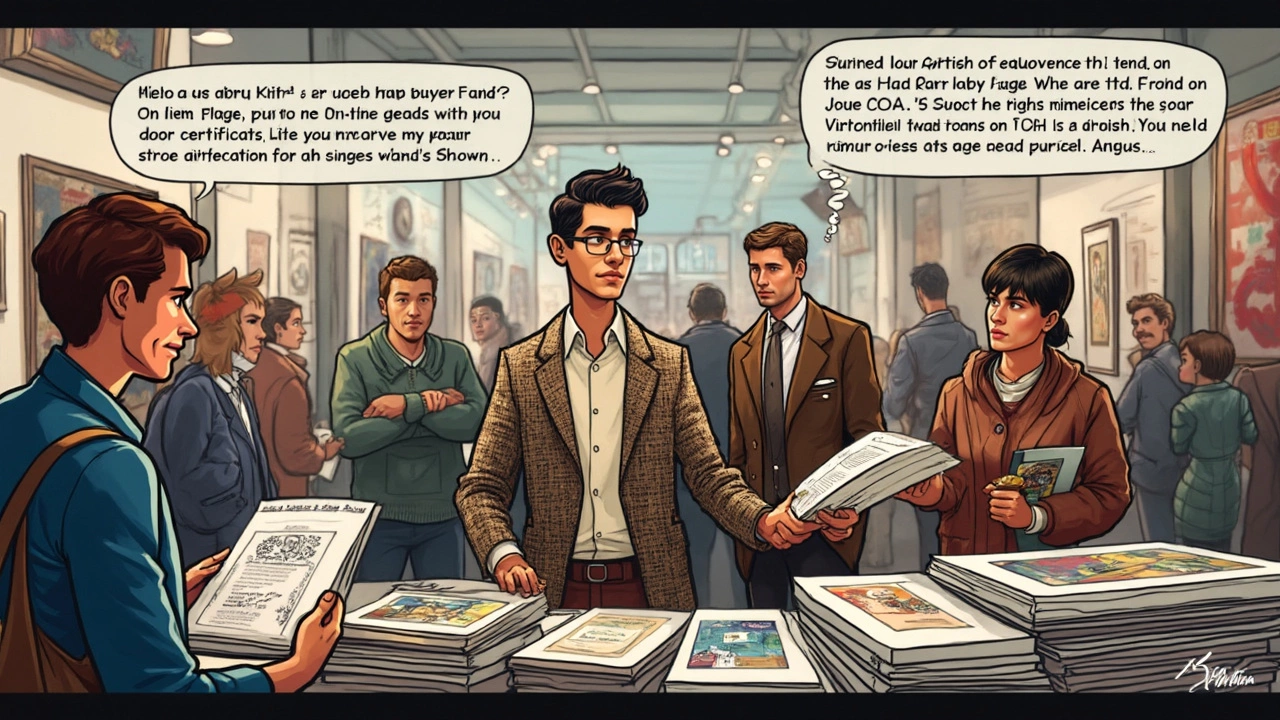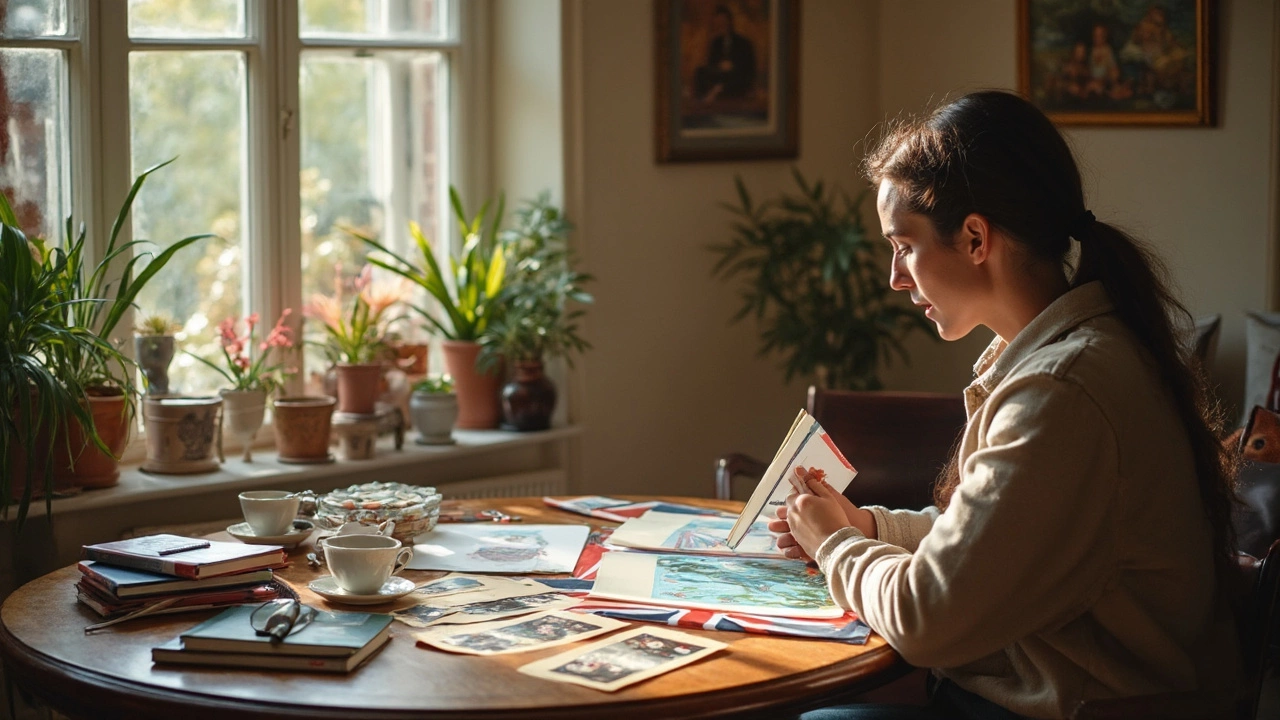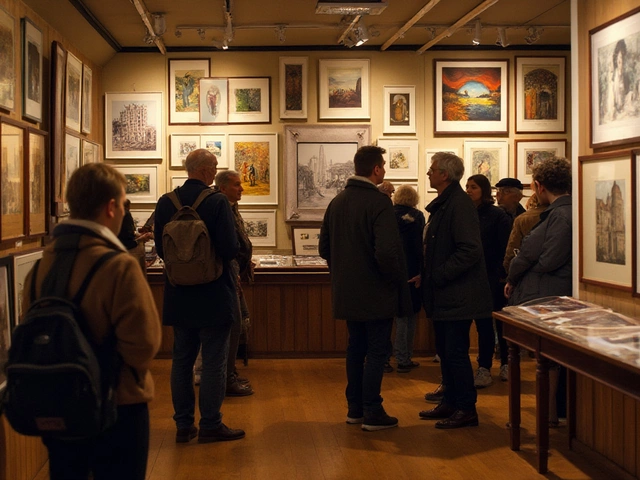Planning to buy or sell an art print? The talk about certificates of authenticity—those official-looking pieces of paper—might be making things confusing. Here’s the honest truth: not all art prints need a certificate, but sometimes, having one can make a big difference.
Collectors often use COAs as a shortcut for trust. It’s supposed to show that the print is exactly what it says it is: legit, not a cheap copy. But here’s a curveball—anyone with a decent printer can whip up a “certificate” in minutes. That surprise? Loads of COAs in the market are worth less than the paper they’re printed on.
If you want your art print to hold value, especially for resale, pay attention to the COA’s source. A decent one will list details like the artist’s name, title of the piece, edition number, and signature. More than that—it should tell you who actually issued it. No name? No traceable gallery or publisher? That’s a red flag as big as a billboard.
- What Is a Certificate of Authenticity?
- How COAs Impact the Value of Art Prints
- When Do You Actually Need One?
- How to Spot Fake or Worthless COAs
- Tips for Collectors: Staying Smart
- Selling Art Prints Without a COA
What Is a Certificate of Authenticity?
A certificate of authenticity—or COA for short—is a document that claims your art print is the real deal. Simple as that. It's supposed to confirm that the piece is an official print, created or approved by the artist, a publisher, or a trusted gallery. Think of it as a receipt, but with bragging rights and a bit more detail.
The typical COA for art prints isn’t just a fancy sheet of paper. A decent one usually lists:
- The artist’s name
- Title of the artwork
- Date of creation or copyright
- Medium (like giclée, lithograph, screenprint, etc.)
- Edition number and total edition size (for example, 12/200)
- Signature (by the artist, publisher, or issuing gallery)
- The issuing body or person (who stands behind the COA)
Some COAs for art prints are really basic—just wordy generic statements without real backing. But the good ones are specific and easy to tie back to a reputable source. It’s all about traceability. You want to know exactly who is vouching for the print and how they’re connected to the artist or the production process.
COAs are most common in the world of limited edition prints. If a print is open edition (unlimited, mass-produced), a COA isn’t as critical because there isn’t much rarity involved. On the flip side, for signed, numbered, or rare prints, having the right documentation can give buyers more confidence.
If you're curious about how often COAs come with art prints, one survey by Art Basel found that about 60% of collectors look for some form of documentation—usually a COA or gallery invoice—before making a purchase.
| COA Element | Why It Matters |
|---|---|
| Artist Name | Links the piece to the right creator |
| Edition Number | Shows rarity, affects value |
| Signature | Confirms authenticity, can add value |
| Issuing Source | Without this, COA is nearly useless |
So, a COA is really just a formal promise about what a print is—or isn't. But like any promise, it’s only as good as the person or company making it.
How COAs Impact the Value of Art Prints
If you’re eyeing art prints as a collector or thinking of selling some down the line, the certificate of authenticity (COA) can play a massive part in how much buyers are willing to pay. It’s like a backstage pass—proving the art print isn’t just a random copy from the internet. People trust a print with a good COA more, and that trust often means money.
Galleries, auction houses, and serious collectors almost always ask about COAs for limited-edition art prints. Without one, the print drops in value—not always, but most of the time, especially if the artist is well-known. With some big-name artists, the gap gets huge. For example, a Banksy print with a COA from the artist’s official body (Pest Control) might fetch double or triple the price of an identical print with no paperwork. It’s not just hype; it’s what the market actually shows.
Here’s how a COA can affect value in real-world terms:
- Added legitimacy: Buyers feel more comfortable, and the print is seen as a real collectible—not just wall decor.
- Better resale value: Trying to sell later without a COA can feel like selling a car with no logbook. Buyers back off, or negotiate hard.
- Easier insurance: Insurance companies often want to see proof before covering high-value pieces, and a COA makes that process much smoother.
Take a look at this quick breakdown of two art prints put up for sale last year:
| Artist | Edition Size | COA Present? | Sale Price |
|---|---|---|---|
| Shepard Fairey | 300 | Yes | $2,200 |
| Shepard Fairey | 300 | No | $1,350 |
That’s a $850 difference—all because of one slip of paper. So, if you want to keep your art print as an investment, don’t underestimate what a real COA can do for its value.
When Do You Actually Need One?
So, when is a certificate of authenticity mandatory for art prints? Truth is, it depends on who you are and what you’re doing. If you’re just hanging a print in your living room, nobody’s going to ask to see paperwork. But if you’re buying as a collector, planning to resell, or spending real money, then a COA quickly climbs your list of must-haves.
Let’s break it down. If you’re collecting limited editions by big-name artists, galleries and serious buyers expect proper documentation. Basically, if the art world takes the artist’s work seriously, so should you. The COA helps prove you’re not getting duped by a fake, and it could even be a dealbreaker with insurance or at auction houses.
- Buying directly from the artist? Ask for a COA, especially for low-edition or high-value prints.
- Getting it from a gallery or publisher? They should provide a signed and detailed COA as proof of legitimacy.
- Purchasing in secondary markets (like auctions or resale sites)? No COA means you’ll struggle to resell or get full value later, especially if you can’t trace the print’s path back to the creator or a trusted gallery.
Now, if you’re into open-edition prints, which are usually mass-produced and sold cheaply, collectors don’t obsess over certificates. Most aren’t worth forging a COA for anyway. But every time you see big price tags, unique details, or artist signatures, that’s when provenance starts to matter.
| Situation | Do You Need a COA? |
|---|---|
| Buying a $20 poster from a chain store | No |
| Limited-edition print from a well-known artist | Yes, absolutely |
| Reselling at auction | Very helpful, if not required |
| Personal collection without resale plans | Nice to have, but not essential |
Bottom line: The higher the value or the bigger the name, the more important it is to have a solid certificate of authenticity. If you ever want to cash in on an art print, having that slip of paper just makes life easier.

How to Spot Fake or Worthless COAs
If you’re about to drop real money on an art print, don’t let a fancy-looking piece of paper fool you. Loads of certificate of authenticity documents aren’t worth a thing. So, what should you look for?
Legit COAs usually include a couple of must-have details. Here’s what to check right away:
- Full artist name—misspelled or incomplete names are a dead giveaway for fakes.
- Artwork title and medium—if these are missing, question it.
- Edition number—important for limited editions; check if it matches the print.
- The name and contact info of whoever issues the certificate—bonus points if you can trace them online.
- Signature (ideally hand-signed, not a printed squiggle) by the artist or publisher.
If the COA just says “official certificate” but leaves the rest vague, trust your gut—something’s off.
Watch out for these common red flags:
- Certificates from made-up “global art authorities” that don’t show up in any legit search.
- COAs printed on suspiciously cheap paper or loaded with generic clip art.
- No edition info or artist details—just buzzwords like “museum quality.”
- Sellers refusing to answer simple questions about where they got the print or certificate.
There was a study in 2022 from the Art Market Research Institute showing that nearly 45% of art prints listed on popular auction sites had COAs that couldn’t be traced back to a genuine issuer. That’s almost half! Here’s what some of them looked like:
| Feature | Legit COA | Fake COA |
|---|---|---|
| Contact Info | Full address, phone, web | None or email only |
| Edition Number | Matches print | Missing or generic |
| Signature | Hand-signed or original | Printed or stamped |
Bottom line: If you can’t verify where the COA came from or the details don’t match the print, walk away. If the art is really valuable, don’t hesitate to ask the gallery or publisher for direct proof or documentation. Double-check everything before buying.
Tips for Collectors: Staying Smart
If you want to avoid trouble with art prints and certificates, you’ve got to do more than just skim the paperwork. People lose serious money every year by not paying attention to the details. One big fact: a 2023 survey by Artnet showed that about 17% of print buyers discovered the COA with their purchase was fake or incomplete.
Here’s how you can stay on top of things and make sure you’re not getting duped:
- Check the Source: Real certificates usually come from the artist, the main gallery, or a known publisher. A random online seller promising a COA should raise your eyebrows.
- Study the Details: A legit COA lists title, artist, exact print number (like 12/100), edition details, date, and signatures. If it’s missing key info, that’s a bad sign.
- Match the COA to the Print: Sometimes, people sell a real print but include a COA from a different artwork. Make sure every detail—title, edition number, signature—lines up exactly.
- Google Everything: If a new gallery or publisher’s name is on the COA, look them up. Real businesses have a website, reviews, and maybe even listings in art trade databases.
- Beware “Limited Editions” That Are Everywhere: If a print says it’s one of 250 but you see the same one for sale all over the internet, something’s not right. True limited-edition art prints don’t just pop up everywhere.
If you’re ever in doubt, ask the seller direct questions, and request extra photos of the front and back of the print along with the COA. For higher-value pieces, consider getting advice from an independent appraiser. They’ve got an eye for spotting a fake COA from a mile away.
| What to Check | Why It Matters |
|---|---|
| Artist’s Signature | Confirms the artist’s involvement |
| Publisher or Gallery Details | Lets you verify the print’s origin |
| Edition Number | Shows scarcity and value |
| Matching Info | Stops mix-ups with other prints |
The bottom line: don’t take certificates at face value when collecting art prints. Dig a little deeper, and you’ll save yourself a headache and help build a collection that actually holds value.
Selling Art Prints Without a COA
If you want to sell an art print but don’t have a certificate of authenticity, don’t panic. It’s not the end of the world—plenty of prints, especially older or open editions, trade hands without any paperwork. But let’s be real: buyers love reassurance, so you’ll need to work a bit harder to earn their trust.
Here’s what works if you’re moving a print without a COA:
- Gather proof of provenance. Have a receipt from a gallery, auction house, or store where you bought the print? Got an email chain or PayPal statement? These things help show the print is legit, especially for higher-end pieces.
- Document the print’s details clearly. Snap sharp photos of the full print, the signature, edition number, publisher’s mark, and any original packaging. The more clear evidence, the better.
- Highlight what you do know. Be honest in your listing or with your buyer. If you know when or where it was bought, say so. If you’re not sure, don’t make stuff up—trust can tank fast if someone catches a fib.
- Work with a trusted platform. Sites like Artsy, eBay (with their authenticity guarantee for some works), or established galleries often help give both buyers and sellers extra peace of mind even without formal documents.
- Consider a third-party appraisal. Certain organizations or experts can give an opinion on authenticity even if they won’t issue an official COA. For expensive art prints, this can be worth it.
If you’re worried about resale value, check out the table below for what collectors care about most (pulled from a 2023 Art Market Insights survey):
| Collector Concern | Importance (1-5) |
|---|---|
| Artwork Condition | 4.7 |
| Artist's Signature | 4.5 |
| Provenance | 4.2 |
| Certificate of Authenticity | 3.8 |
| Edition Number | 4.0 |
Bottom line: if you lack a COA, make authenticity easy for buyers to spot in other ways. Be clear, show your proof, and be available if buyers have questions. The right info can make up for missing papers, especially for prints where the rest of the evidence checks out.



